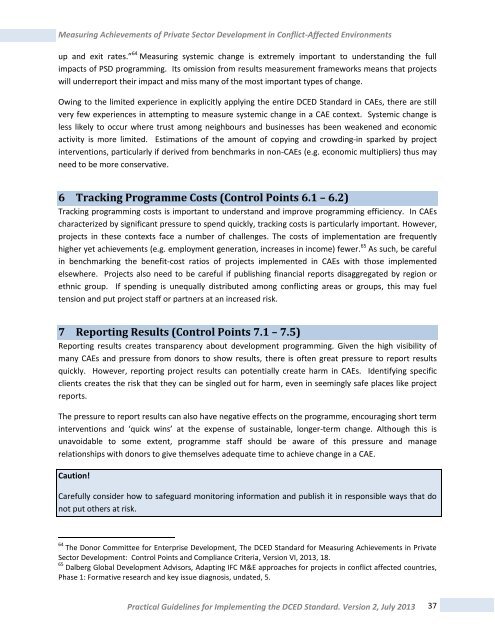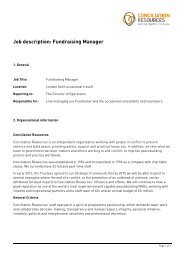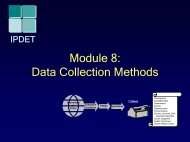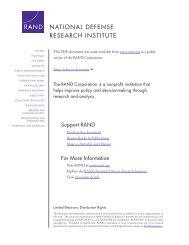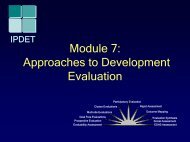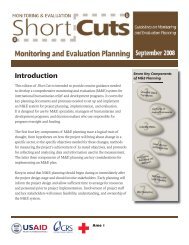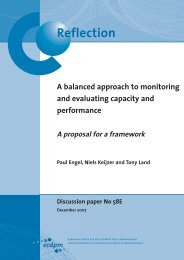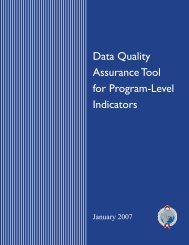Measuring Achievements of Private Sector Development in ... - DCED
Measuring Achievements of Private Sector Development in ... - DCED
Measuring Achievements of Private Sector Development in ... - DCED
Create successful ePaper yourself
Turn your PDF publications into a flip-book with our unique Google optimized e-Paper software.
<strong>Measur<strong>in</strong>g</strong> <strong>Achievements</strong> <strong>of</strong> <strong>Private</strong> <strong>Sector</strong> <strong>Development</strong> <strong>in</strong> Conflict-Affected Environments<br />
up and exit rates.” 64 <strong>Measur<strong>in</strong>g</strong> systemic change is extremely important to understand<strong>in</strong>g the full<br />
impacts <strong>of</strong> PSD programm<strong>in</strong>g. Its omission from results measurement frameworks means that projects<br />
will underreport their impact and miss many <strong>of</strong> the most important types <strong>of</strong> change.<br />
Ow<strong>in</strong>g to the limited experience <strong>in</strong> explicitly apply<strong>in</strong>g the entire <strong>DCED</strong> Standard <strong>in</strong> CAEs, there are still<br />
very few experiences <strong>in</strong> attempt<strong>in</strong>g to measure systemic change <strong>in</strong> a CAE context. Systemic change is<br />
less likely to occur where trust among neighbours and bus<strong>in</strong>esses has been weakened and economic<br />
activity is more limited. Estimations <strong>of</strong> the amount <strong>of</strong> copy<strong>in</strong>g and crowd<strong>in</strong>g-<strong>in</strong> sparked by project<br />
<strong>in</strong>terventions, particularly if derived from benchmarks <strong>in</strong> non-CAEs (e.g. economic multipliers) thus may<br />
need to be more conservative.<br />
6 Track<strong>in</strong>g Programme Costs (Control Po<strong>in</strong>ts 6.1 – 6.2)<br />
Track<strong>in</strong>g programm<strong>in</strong>g costs is important to understand and improve programm<strong>in</strong>g efficiency. In CAEs<br />
characterized by significant pressure to spend quickly, track<strong>in</strong>g costs is particularly important. However,<br />
projects <strong>in</strong> these contexts face a number <strong>of</strong> challenges. The costs <strong>of</strong> implementation are frequently<br />
higher yet achievements (e.g. employment generation, <strong>in</strong>creases <strong>in</strong> <strong>in</strong>come) fewer. 65 As such, be careful<br />
<strong>in</strong> benchmark<strong>in</strong>g the benefit-cost ratios <strong>of</strong> projects implemented <strong>in</strong> CAEs with those implemented<br />
elsewhere. Projects also need to be careful if publish<strong>in</strong>g f<strong>in</strong>ancial reports disaggregated by region or<br />
ethnic group. If spend<strong>in</strong>g is unequally distributed among conflict<strong>in</strong>g areas or groups, this may fuel<br />
tension and put project staff or partners at an <strong>in</strong>creased risk.<br />
7 Report<strong>in</strong>g Results (Control Po<strong>in</strong>ts 7.1 – 7.5)<br />
Report<strong>in</strong>g results creates transparency about development programm<strong>in</strong>g. Given the high visibility <strong>of</strong><br />
many CAEs and pressure from donors to show results, there is <strong>of</strong>ten great pressure to report results<br />
quickly. However, report<strong>in</strong>g project results can potentially create harm <strong>in</strong> CAEs. Identify<strong>in</strong>g specific<br />
clients creates the risk that they can be s<strong>in</strong>gled out for harm, even <strong>in</strong> seem<strong>in</strong>gly safe places like project<br />
reports.<br />
The pressure to report results can also have negative effects on the programme, encourag<strong>in</strong>g short term<br />
<strong>in</strong>terventions and ‘quick w<strong>in</strong>s’ at the expense <strong>of</strong> susta<strong>in</strong>able, longer-term change. Although this is<br />
unavoidable to some extent, programme staff should be aware <strong>of</strong> this pressure and manage<br />
relationships with donors to give themselves adequate time to achieve change <strong>in</strong> a CAE.<br />
Caution!<br />
Carefully consider how to safeguard monitor<strong>in</strong>g <strong>in</strong>formation and publish it <strong>in</strong> responsible ways that do<br />
not put others at risk.<br />
64 The Donor Committee for Enterprise <strong>Development</strong>, The <strong>DCED</strong> Standard for <strong>Measur<strong>in</strong>g</strong> <strong>Achievements</strong> <strong>in</strong> <strong>Private</strong><br />
<strong>Sector</strong> <strong>Development</strong>: Control Po<strong>in</strong>ts and Compliance Criteria, Version VI, 2013, 18.<br />
65 Dalberg Global <strong>Development</strong> Advisors, Adapt<strong>in</strong>g IFC M&E approaches for projects <strong>in</strong> conflict affected countries,<br />
Phase 1: Formative research and key issue diagnosis, undated, 5.<br />
Practical Guidel<strong>in</strong>es for Implement<strong>in</strong>g the <strong>DCED</strong> Standard. Version 2, July 2013<br />
37


